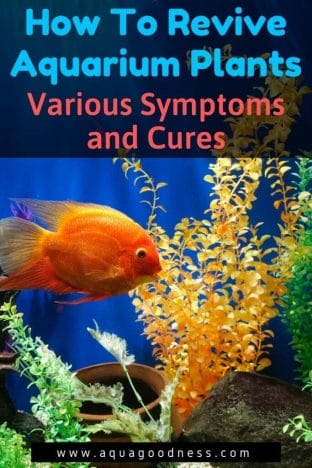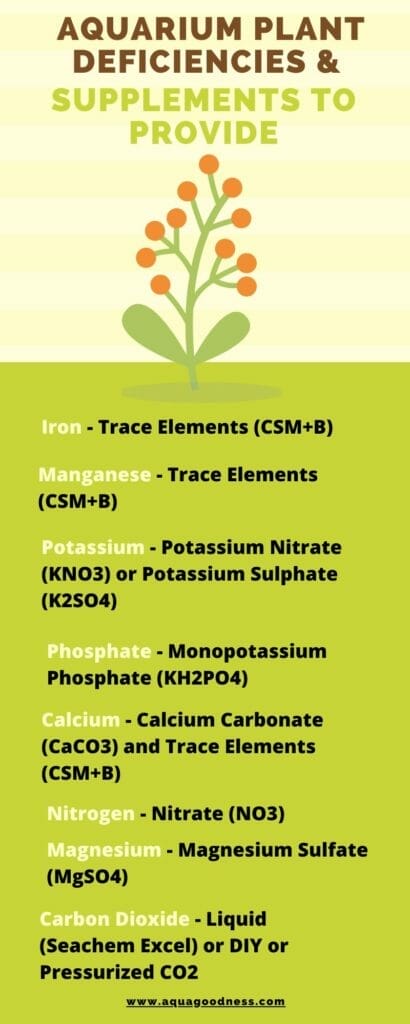Aquarium plants are great. There are a lot of benefits of keeping aquarium plants in your aquarium.
They help to oxygenate the aquarium. They help to emulate the natural habitat of the fish in your aquarium and they also provide you a chance to design your aquarium and give it a unique look.
Now I know it is very frustrating to see aquarium plants die.
No worries, in this article, I am going to show you different reasons that may be causing this problem and also how to revive your aquarium plants.
How to revive your aquarium plants? Aquarium plants die usually because of any nutrient deficiency. So if you supplement the plants with fertilizers containing the nutrient then you can revive your aquarium plants.

Table of Contents
How to know if your aquarium plants are dying?
There are various signs that show your aquarium plants are struggling in your aquarium and dying.
The signs are as follows:
- The leaves of aquarium plants are turning brown
- Aquarium plants are disintegrating
- Aquarium plants are melting
- There are small pinholes on the leaves of aquarium plants
- The leaves of aquarium plants are turning white
- The leaves of aquarium plants are falling off.
If you notice any of the above sign then it suggests that your aquarium plant is suffering any nutrient deficiency in your aquarium
And you should take some action to revive your aquarium plants!

6 Tips to Take Care of Live Plants in Aquarium (For Beginners)
Why your aquarium plants are dying and how to revive them?
As mentioned earlier, aquarium plants die usually because of some nutrient deficiency in your aquarium.
There are some common nutrient deficiencies that can cause the death of your aquarium plant.
They are as follows:
Carbon dioxide deficiency
Carbon dioxide deficiency may be the reason your aquarium plants are dying.
The symptom of CO2 deficiency is yellow leaves and cripple the growth of the plants.
In the case of CO2 deficiency, you should supplement your plants with CO2 fertilizers or pressurized CO2.
Also, you should regularly monitor the Carbon dioxide levels in your aquarium using a drop checker.
If you have a very heavily planted aquarium then the carbon dioxide level should be about 20 to 30 mg / l in your aquarium.
Nitrogen deficiency
Now nitrogen deficiency is one of the most common deficiencies that occur in the aquarium if you are just starting out with the hobby.
Nitrogen deficiency occurs when there is not a sufficient amount of nitrate in the aquarium.
The thing is, plants require nitrate for or their proper growth and if there is not sufficient amount of nitrate in the water then it can cause yellowing leaves or translucent leaves in aquarium plants.
Usually, nitrogen deficiency is caused if you are doing water changes very frequently.
Because when you do water change very frequently you are removing all the ammonia and nitrate from the water and there is not sufficient nitrate or ammonia for the plants to consume.
So, if you notice symptoms of nitrogen deficiency i.e. the leaves start yellowing and turning translucent then there are a couple of ways to increase nitrate in the aquarium.
Feed your fish
The first way is to feed your fish so they can poop and that will ultimately get converted into nitrate or ammonia which will provide nitrogen to the plants.
Use fertilizers
Another way to increase nitrogen in your aquarium is by using fertilizers.
If you are not already using fertilizers then you should start using fertilizers to increase nitrogen levels in your aquarium.
If you are already using fertilizers then you should increase its dose.
Because most of the time what happens is that the plants grow in the aquarium but the amount of fertilizers you provide to the plants is the same.
So basically you are providing less fertilizers than necessary to your aquarium plants.
In a nutshell, you should increase the fertilizer dozing with the growth of the plant.
When you introduce a new plant in your aquarium you may notice that its leaves start yellowing and fall off.
The thing is most of the plants grown in some kind of farm before you put them in your aquarium.
And when you introduce them into your aquarium, the plants actually have to adjust to the new environment.
In this process, the existing leaves of plants turn yellow and fall apart and then the new leaves start forming which are comfortable with the environment of your aquarium.
Iron deficiency
In the case of iron deficiency, the leaves of the aquarium plants start turning yellow or lime-yellow in color and its veins get darker in color.
So, to overcome iron deficiency you should supplement your aquarium with iron-rich fertilizers.
Most of the fertilizers contain iron in a very low amount. So in case of iron deficiency, you should provide complete iron fertilizers to your aquarium plants.
Potassium deficiency
Potassium is one of the essential nutrient for plant growth and development.
It is very easy to identify potassium deficiency.
You will see small pinholes on the leaves of your aquarium plant in case of potassium deficiency.
To cope with this deficiency, you should supplement your aquarium plants with fertilizers containing potassium.
Phosphate deficiency
If you notice the leaves of your aquarium plants are turning yellow and there are some brown patches and a big hole in the leaf then it is a symptom of phosphate deficiency.
In the case of phosphorus deficiency, you should supplement your aquarium plants with fertilizers containing phosphate.
Magnesium deficiency
In the case of magnesium deficiency, the leaves of your aquarium plant will fade in color.
They will get light green and the veins of the leaves will be dark green.
So, in case of magnesium deficiency, you should supplement your aquarium plants with fertilizers containing magnesium.

Calcium deficiency
If you noticed that new leaves of your aquarium plants are relatively short and light green or lime green in color then it is a sign of calcium deficiency.
This deficiency is very rare because if you are using tap water in your aquarium then chances are it contains calcium.
In the case of calcium deficiency, you should supplement for aquarium plants with fertilizers containing calcium.
So, as you can see, the solution for most of the deficiencies is providing fertilizers to your plants.
Or if you are already supplementing fertilizers then you should increase its dose.
While supplementing fertilizers make sure that it does contain the macronutrient or micronutrient which lacks in your aquarium.
For example, if you noticed an iron deficiency in your aquarium then you should supplement the fertilizer that actually contains iron in good amount or you can use complete iron fertilizers.
After supplementing your plants with fertilizers you should wait for 2-3 weeks to notice any improvement.
20 Tips to Maintain a Healthy Aquarium
FAQ
How do I make my aquarium plants thrive?
It really comes down to providing an ideal environment for the growth of the aquarium plants to make them thrive in your aquarium.
This includes making sure that your aquarium has all the essential micro and macronutrients as well as carbon dioxide in the aquarium.
You should also make sure that you are providing sufficient lighting to your aquarium plants.
One little hack to grow your aquarium plants fast is to trim your plants regularly.
How long do aquarium plants live?
The lifespan of aquarium plants varies greatly from 1 year to up to 20 years.
The lifespan of the plant really depends on the species of the plant.
Basically, there are three kinds of aquarium plants.
The first is annuals these are the plants that complete their whole life cycle within one season.
The second type of aquarium plant is biennials.
These plants have a longer lifespan.
Biennial plants live for multiple seasons.
They grow in first season then they flower in the second season and then they dormant in the third season usually it is dry or winter season.
The third kind of aquarium plant is perennial.
These plants have a way longer life then annuals and biennials.
These plants grow in the first season then they flower in the second season and in the third season they set their seeds and after some dormancy period, they again repeat the process.
Can dead plants kill fish?
Yes, dead plants get decomposed and lower the oxygen levels in the aquarium that can cause the death of the fish in your aquarium.
So, if you notice any dead plant in your aquarium, you should immediately remove it before it gets decomposed.
Can yellow leaves turn green again?
Usually, the yellow leaves of plants don’t turn vibrant green again.
So it is better to cut them off for good.
Is fish waste good for aquarium plants?
Yes, fish waste works as a very good fertilizer for aquarium plants.
Conclusion
So, the first step for reviving your aquarium plant is to know what deficiency is causing the issue in your aquarium plants.
Once you identified the issue then you should react accordingly.
Usually, it is adding fertilizers.
But while choosing the fertilizers make sure to choose the fertilizers that actually contain the nutrient in a good amount which is lacking in your aquarium.
After that, you should wait for about two to three weeks to see any improvements.